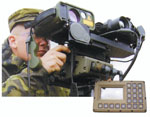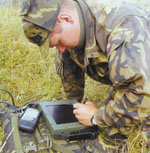Czech Army Deploys Digital Command System
 |
 |
| The Czech army is deploying the Retia advanced command and control system (RACCOS) to its air defense units. This NATO interoperable system is the Czech military’s first all digital command system for short- and medium-range anti-aircraft weapons. Designed for use at the battalion and battery levels, its core unit is a mobile command center housed in truck-mounted shelter. |
A new NATO member nation is deploying an advanced air defense command and control system that provides its forces with enhanced situational awareness and that interoperates with allied forces’ systems. The system connects short- and medium-range anti-aircraft weapons batteries into a battalion-level network. It is designed to provide commanders with a real-time picture of friendly and enemy air operations over the battlefield.
Developed for the
Operational data that is collected from other air defense networks, the system’s own radar, observers and adjacent units create an air picture. This real-time map of friendly and enemy aircraft in a region helps commanders to identify targets and their characteristics. The system displays the air picture and predicts target positions in relation to deployed air defense units and is designed to determine the optimal target allocation for defensive fire.
Parts of the RACCOS system began entering service with the Czech military in November 2005. This initial deployment consisted of command and control posts and terminals linked to sensors and weapons. RACCOS is a large system with many components, such as command vehicles that are being phased into service this year, explains Pavel Muzak, technical director and board member, Retia Special Electronics,
The system originated from a Ministry of Defense (MOD) requirement in the mid-1990s to replace the aging Russian-designed PU-12 command and control system then used to direct the military’s SA-13 surface-to-air missiles. In 1998, the MOD requested that Retia develop a technology demonstrator for a new system. This was the RACCOS prototype that was delivered in 2001. The contract for RACCOS was signed in 2004, and delivery of the last pieces of equipment is scheduled for this year.
During the late 1990s and early 2000s, the Czech MOD underwent a series of structural and budget changes. Muzak says that the main influence this situation had on the system’s development was to emphasize joint cooperation between the army and air force, which caused some modifications in the command and control system. He explains that after having had its software reconfigured for interservice operations, RACCOS now is able to coordinate short- and medium-range air defense missions.
RACCOS consists of a battalion/battery command and control post (BCCP) housed in a vehicle shelter for mobility, weapons terminals, air observer devices and a training simulator. The BCCP features two-way voice and data communication via radio and landline links; real-time sensor data processing, display and recording; automatically updated air picture data; tactical coordination of air and ground units; location information of friendly command nodes; and weapons systems and system diagnostics. The BCCP is operated by three people: an air picture operator, a tactical display operator and a driver/mechanic. The shelter houses a merged air situation display console and a tactical display console, communications equipment, navigation and diagnostics systems, data recorder and simulation systems, and a feed for reconnaissance system sensor data. The truck and shelter also are equipped with air filtration and air conditioning units.
Air situation data can be displayed on a digital map, with subordinate units and areas of weapons coverage indicated on screen. The console can be set to perform target selection automatically and to suggest target allocation to air defense units. The operator can then confirm or change the allocations as needed. The BCCP’s communications system also allows the air situation operator to know the locations of allied units to minimize the potential for friendly fire incidents.
 |
 |
| The RACCOS system includes handheld terminals designed to provide battery commanders with tactical data and manportable air observation equipment to locate and identify enemy aircraft in areas without radar coverage. |
A communications unit installed in the BCCP provides synchronous data and voice transmissions. The system is designed to be resistant to jamming and interception, and its software and data formats meet NATO standards. The radio network linking the BCCP to other units uses a frequency hopping ultrahigh frequency (UHF) system.
A combined inertial and satellite navigation system provides navigation and system diagnostics. The communication unit also continuously records tactical air picture data, location, diagnostics and voice messages. This data is stored for future analysis or for training purposes.
Air defense batteries are linked back to the BCCP via a handheld weapons terminal. The terminal enables data and voice communications, and it provides the weapon’s commander with tactical information from the BCCP.
Additional air situation data is provided by an air observer system known as ReTOB, a manportable electro-optical observation system designed to detect targets in areas without radar coverage. The ReTOB unit is equipped with a ruggedized portable computer that collects and transmits target information back to the command post via a UHF radio link.
Developing and managing a digital data network proved challenging because RACCOS is the Czech military’s first command and control system based on signal hopping digital radios. The equipment uses Thales PR-4G tactical radios transmitting a mix of sensor data and digital voice communications across a shared network. Muzak says that it was necessary to solve the issue of logging in all of the different radio elements and to address data distribution across the wireless network. He believes that RACCOS has an adaptive network subsystem that is resistant to battle damage.
The system is interoperable with NATO data-sharing standards such as Link 11B and Link 16. An important standard that RACCOS uses is the low level air picture interface (LLAPI). Muzak explains that LLAPI enables NATO short-range air defense systems to share information about the current air situation and to allow direct fire for engagement control. Data between national systems is transmitted via fiber optic cable. The LLAPI protocol allows units up to 30 kilometers away or 1.5 kilometers high to exchange data. To eliminate delays and to transmit as much data as possible, the signals are not encrypted. The data is then converted to specific national formats via Link 16. Muzak notes that the Czech army is using LLAPI to connect RACCOS to a German air defense command and control system.
RACCOS will receive an additional upgrade as part of the modernization of the Russian-made 2K-12 KUB surface-to-air missile system. The system’s engagement control functions will be modified, as will certain operator roles and equipment implementation. This program is scheduled to be completed by the end of 2008.
Web Resource
Retia Special Electronics: www.retia.cz




Comments